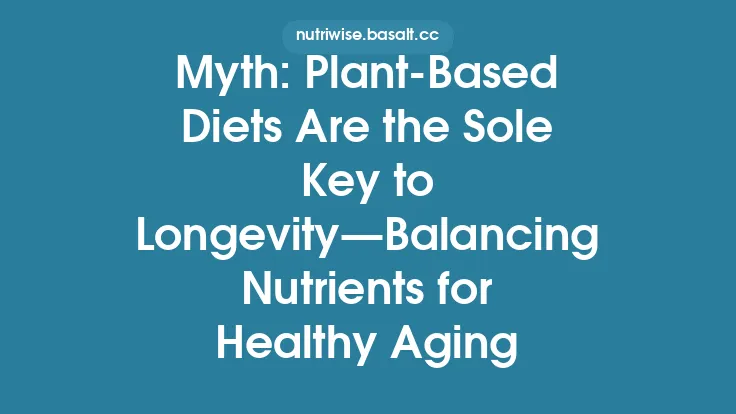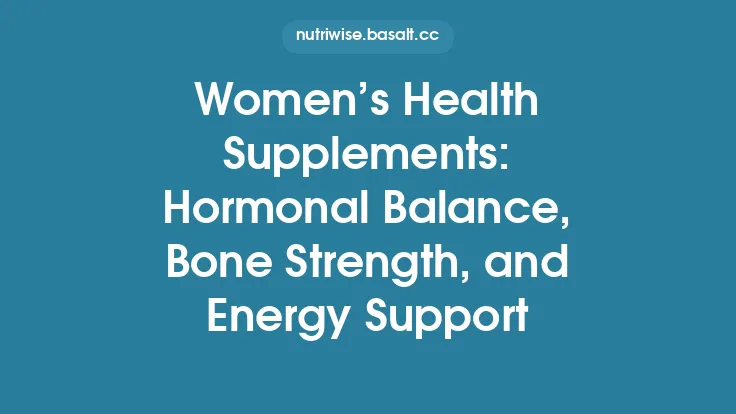Women’s bodies undergo profound physiological changes from the first menstrual cycle through the later years of life. These shifts alter the demand for key minerals and vitamins, making a one‑size‑fits‑all supplement strategy insufficient. By understanding how iron, calcium, and a handful of other targeted nutrients intersect with each life stage, women can make informed choices that support blood health, skeletal integrity, and overall well‑being without relying on guesswork or generic “women’s multivitamins.”
Understanding Women’s Nutrient Needs Across the Lifespan
| Life Stage | Primary Hormonal/Physiological Drivers | Key Nutrient Concerns |
|---|---|---|
| Adolescence (12‑19 yr) | Rapid growth, onset of menstruation | Iron loss with menses, calcium for peak bone mass |
| Reproductive Years (20‑35 yr) | Regular ovulatory cycles, potential pregnancy | Sustained iron, calcium, folate, B‑vitamins |
| Pregnancy (≈9 mo) | Fetal tissue formation, expanded blood volume | High‑dose iron, calcium, folate, vitamin B12 |
| Lactation (≈6‑12 mo) | Milk production, continued iron loss | Iron maintenance, calcium for milk, magnesium |
| Perimenopause (≈40‑55 yr) | Fluctuating estrogen, menstrual irregularities | Iron re‑evaluation, calcium for bone loss, vitamin K2 |
| Menopause (≥55 yr) | Low estrogen, accelerated bone remodeling | Calcium & vitamin D, magnesium, zinc for hormonal balance |
These stages illustrate why a static supplement regimen can quickly become mismatched. The following sections break down the two cornerstone minerals—iron and calcium—before expanding to complementary nutrients that address the nuanced demands of each phase.
Iron: The Lifeline for Women’s Blood Health
Iron Requirements by Life Stage
| Stage | Recommended Dietary Allowance (RDA)* | Typical Supplemental Dose (if needed) |
|---|---|---|
| Adolescents (girls 12‑18) | 15 mg/day | 18‑27 mg elemental iron (often as ferrous sulfate) |
| Adult women (19‑50) | 18 mg/day | 27‑45 mg elemental iron |
| Pregnancy | 27 mg/day | 30‑60 mg elemental iron (higher‑dose prenatal formulas) |
| Lactation | 9 mg/day | 18‑27 mg elemental iron (if dietary intake is low) |
| Post‑menopause | 8 mg/day | Usually no supplement needed unless deficiency is documented |
\*RDAs are from the Institute of Medicine (2020).
Forms of Supplemental Iron and Bioavailability
| Form | Typical Elemental Iron Content (per 325 mg tablet) | Absorption Rate (approx.) | Common Side‑Effect Profile |
|---|---|---|---|
| Ferrous sulfate | 65 mg | 10‑15 % | Constipation, nausea, dark stools |
| Ferrous gluconate | 35 mg | 8‑12 % | Milder GI upset |
| Ferrous fumarate | 106 mg | 12‑18 % | Similar to sulfate, but larger dose per tablet |
| Iron bisglycinate (chelated) | 25‑30 mg | 20‑30 % | Minimal GI irritation |
| Heme iron polypeptide | 12‑15 mg | 25‑35 % | Well tolerated, derived from animal hemoglobin |
Why the form matters: Chelated iron (e.g., bisglycinate) binds to amino acids, shielding it from inhibitors such as phytates and polyphenols, which can be abundant in plant‑based diets. This makes chelated iron especially valuable for vegetarians or those who consume high‑fiber meals.
Managing Side Effects and Interactions
- Take with food (except for chelated forms, which can be taken on an empty stomach) to reduce nausea.
- Avoid concurrent calcium, high‑dose zinc, or antacids within a 2‑hour window, as they compete for the same intestinal transporters.
- Vitamin C (ascorbic acid) boosts absorption – a small glass of orange juice or a 100 mg vitamin C tablet taken together with iron can increase uptake by up to 50 %.
- Monitor for iron overload in women with hereditary hemochromatosis or those receiving repeated high‑dose therapy; serum ferritin and transferrin saturation should be checked periodically.
Calcium: Building and Maintaining Skeletal Resilience
Calcium Demands Through the Ages
- Adolescence: 1,300 mg/day (critical window for achieving ~90 % of peak bone mass).
- Adult women (19‑50): 1,000 mg/day.
- Post‑menopause: 1,200 mg/day (to counteract estrogen‑driven bone resorption).
While calcium is most famous for its role in bone, it also participates in muscle contraction, nerve transmission, and blood clotting. The challenge for many women is not just meeting the RDA but ensuring the calcium is utilized effectively.
Choosing the Right Calcium Supplement
| Factor | Practical Guidance |
|---|---|
| Elemental calcium per dose | Aim for ≤ 500 mg per tablet/capsule; the intestine absorbs calcium most efficiently in smaller amounts. |
| Calcium carbonate vs. citrate | Carbonate provides ~40 % more elemental calcium but requires an acidic environment (take with meals). Citrate is more soluble, suitable for those on proton‑pump inhibitors or with low stomach acid. |
| Co‑factors | Vitamin D (800‑1,000 IU/day) is essential for calcium absorption; many calcium products now include vitamin D3. |
| Timing | Split the total daily dose into two or three servings to maximize absorption and reduce gastrointestinal discomfort. |
Complementary Micronutrients for Women’s Health
Folate and Vitamin B12 for Reproductive Health
- Folate (400‑800 µg DFE) is crucial for DNA synthesis and preventing neural‑tube defects during early pregnancy. Women of childbearing age should consider a prenatal‑grade folic acid supplement, especially if dietary intake of leafy greens and legumes is low.
- Vitamin B12 (2.4 µg) supports red‑blood‑cell formation and neurological function. Since B12 is primarily found in animal products, vegetarians and vegans often benefit from a cyanocobalamin or methylcobalamin supplement (25‑100 µg).
Magnesium for Muscular and Metabolic Support
Magnesium (310‑420 mg/day depending on age) assists in over 300 enzymatic reactions, including those involved in energy production and calcium regulation. A magnesium glycinate or magnesium citrate supplement can help alleviate menstrual cramps, improve sleep quality, and support glucose metabolism without the laxative effect of magnesium oxide.
Vitamin K2 and Its Role in Calcium Utilization
Vitamin K2 (menaquinone‑7) activates osteocalcin, a protein that directs calcium to bone rather than soft tissue. A daily dose of 90‑120 µg of MK‑7 has been shown to improve bone mineral density in post‑menopausal women when combined with adequate calcium and vitamin D.
Zinc and Selenium for Hormonal Balance
- Zinc (8 mg/day) is a cofactor for enzymes that modulate estrogen metabolism and immune signaling. Subclinical zinc deficiency can manifest as irregular cycles or reduced fertility. A zinc picolinate supplement (15‑30 mg) is well absorbed and less likely to cause copper depletion when paired with a modest copper (1 mg) dose.
- Selenium (55 µg/day) supports thyroid hormone conversion, which influences menstrual regularity and metabolic rate. Brazil nuts (1‑2 nuts) provide the RDA, but a selenium yeast supplement (50‑100 µg) offers a consistent alternative for those with limited nut consumption.
Special Considerations for Pregnancy and Lactation
Iron and Calcium Strategies
- Iron: Prenatal formulas typically contain 27‑30 mg elemental iron, often as ferrous fumarate. Women who experience severe nausea may switch to a slow‑release iron bisglycinate to improve tolerance.
- Calcium: The recommended 1,000 mg/day can be met through a combination of diet (dairy, fortified plant milks, leafy greens) and a 500 mg calcium citrate supplement taken twice daily.
Additional Nutrients
- Iodine (150 µg/day) is essential for fetal neurodevelopment; a prenatal multivitamin should include this, or a separate iodine (150 µg) tablet can be used.
- Vitamin D (600‑800 IU/day) supports calcium absorption and immune modulation during pregnancy; many prenatal products now contain 400‑600 IU, but a modest vitamin D3 supplement (1,000 IU) may be advisable for women with limited sun exposure.
Perimenopause and Menopause: Adjusting Supplement Strategies
Calcium and Vitamin D (Brief Overview)
Bone loss accelerates after menopause due to declining estrogen. Maintaining 1,200 mg calcium and 800‑1,000 IU vitamin D daily helps preserve bone mineral density. A combined calcium citrate + vitamin D3 tablet taken with meals is a convenient option.
Iron Management Post‑Menstruation
Many women experience lighter periods or amenorrhea during perimenopause, reducing iron loss. Routine iron supplementation should be re‑evaluated; unnecessary iron can increase oxidative stress. A serum ferritin test can guide whether to continue, reduce, or discontinue iron.
Supporting Hormonal Shifts with Targeted Nutrients
- Magnesium (350‑420 mg) can alleviate hot flashes and improve sleep quality.
- Vitamin K2 continues to aid calcium placement, especially as bone remodeling rates change.
- B‑complex (B6, B12, folate) supports energy metabolism and mood stability during hormonal fluctuations.
Practical Guidance for Selecting Quality Supplements
- Third‑Party Verification – Look for seals from USP, NSF, or ConsumerLab, which confirm label accuracy and absence of contaminants.
- Formulation Transparency – The label should list the exact chemical form (e.g., ferrous bisglycinate, calcium citrate) and the amount of elemental mineral, not just the compound weight.
- Avoid Unnecessary Additives – Artificial colors, excess sugars, or proprietary blends can obscure actual dosages.
- Timing & Food Interactions –
- Iron: empty stomach or with vitamin C; avoid calcium‑rich meals.
- Calcium: with meals for carbonate; any time for citrate.
- Magnesium: preferably in the evening to support relaxation.
- When to Seek Professional Advice –
- Persistent fatigue, hair loss, or pica (craving non‑food substances) may signal iron deficiency.
- Recurrent fractures or low bone density warrant a bone‑health specialist’s evaluation.
- Pregnancy, lactation, or chronic medical conditions (e.g., CKD, IBD) require individualized dosing.
Frequently Asked Questions
Q: Can I take a “women’s multivitamin” instead of individual iron and calcium supplements?
A: A standard multivitamin often provides only 10‑15 % of the RDA for iron and calcium, insufficient for the heightened needs during menstruation, pregnancy, or menopause. Targeted supplementation ensures you meet the specific demand of each life stage.
Q: Is it safe to combine iron and calcium in the same pill?
A: Calcium can inhibit non‑heme iron absorption when taken simultaneously. Separate dosing by at least two hours is recommended for optimal uptake.
Q: How do I know if I need a chelated iron product?
A: If you experience gastrointestinal upset with ferrous sulfate or follow a high‑fiber/plant‑based diet, a chelated form (bisglycinate or gluconate) often improves tolerance and absorption.
Q: Do I need to cycle on and off calcium supplements?
A: No. Calcium is a nutrient required daily. Consistency, paired with adequate vitamin D, is more important than cycling.
Q: What laboratory tests should I request before starting supplements?
A: Basic panels include serum ferritin, transferrin saturation, 25‑hydroxy vitamin D, and a comprehensive metabolic panel. For post‑menopausal women, a bone‑density scan (DEXA) can guide calcium and vitamin K2 needs.
Closing Thoughts
Women’s nutritional landscapes are dynamic, shaped by hormonal tides, reproductive milestones, and the inevitable march of age. Iron and calcium remain foundational pillars, but they function best when integrated with a suite of complementary nutrients—folate, B12, magnesium, vitamin K2, zinc, and selenium—that address the specific physiological demands of each stage. By selecting high‑quality, appropriately dosed supplements and aligning them with dietary patterns and medical guidance, women can sustain optimal health, energy, and resilience throughout the entire lifespan.





